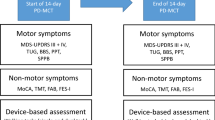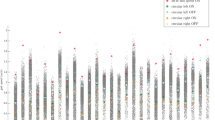Abstract
Parkinson’s disease (PD) is often divided into tremor dominant (TD) and postural instability gait difficulty (PIGD) subtypes. However, objective measures of gait (e.g., stride length, variability) and balance have not been well studied in these subtypes. To better understand these motor subtypes, we objectively quantified gait and balance and their behavioral correlates. 110 patients with PD underwent a clinical evaluation and were stratified into PIGD and TD subtypes. Participants walked under single and dual task conditions while wearing a single body-fixed sensor, both “OFF” and “ON” medications and at home for 3 days. We also examined performance-based tests of mobility, balance, and fall risk. Stricter criteria were also applied, dividing the subjects into predominant representative subgroups: p-PIGD and p-TD. Both the PIGD (n = 62) and TD (n = 42) groups and the p-PIGD (n = 31) and p-TD (n = 32) subgroups were similar with respect to basic disease characteristics (e.g., disease duration, p > 0.69). Surprisingly gait speed, stride length, and variability did not differ between the PIGD and TD groups (p > 0.05). In contrast, the p-PIGD group had reduced gait speed (under single and dual task conditions), shorter strides, increased stride variability, and decreased stride regularity (regularity: p-PIGD 0.66 ± 0.10; p-TD 0.74 ± 0.08; p = 0.003). The p-PIGD group also scored worse on performance-based tests, compared to the p-TD. Clinical assessments of the disturbances seen in patients with the PIGD subtype are not consistent with objective measures; overlapping between the groups is seen in many objective features of gait and balance. These findings suggest that the proposed alternate classification scheme may be useful.

Similar content being viewed by others
References
Jankovic J (2008) Parkinson’s disease: clinical features and diagnosis. J Neurol Neurosurg Psychiatry 79:368–376
Jankovic J, McDermott M, Carter J, Gauthier S, Goetz C, Golbe L, Huber S, Koller W, Olanow C, Shoulson I (1990) Variable expression of Parkinson’s disease: a base-line analysis of the DATATOP cohort. The Parkinson Study Group. Neurology 40:1529–1534
van Rooden SM, Colas F, Martinez-Martin P, Visser M, Verbaan D, Marinus J, Chaudhuri RK, Kok JN, van Hilten JJ (2011) Clinical subtypes of Parkinson’s disease. Mov Disord 26:51–58
Rajput AH, Voll A, Rajput ML, Robinson CA, Rajput A (2009) Course in Parkinson disease subtypes: a 39-year clinicopathologic study. Neurology 73:206–212
Fahn S, Elton R, Members of the UPDRS Development Committee (1987) Unified Parkinson’s disease rating scale. In: Fahn S, Marsden CD, Calne D, Goldstein M (eds) Recent developments in Parkinson’s disease. Macmillan Health Care Information, Florham Park, pp 153–163
Herman T, Rosenberg-Katz K, Jacob Y, Auriel E, Gurevich T, Giladi N, Hausdorff JM (2013) White matter hyperintensities in Parkinson’s disease: do they explain the disparity between the postural instability gait difficulty and tremor dominant subtypes? PLoS ONE 8:e55193
Herman T, Weiss A, Brozgol M, Giladi N, Hausdorff JM (2014) Identifying axial and cognitive correlates in patients with Parkinson’s disease motor subtype using the instrumented Timed Up and Go. Exp Brain Res 232:713–721
Rosenberg-Katz K, Herman T, Jacob Y, Giladi N, Hendler T, Hausdorff JM (2013) Gray matter atrophy distinguishes between Parkinson disease motor subtypes. Neurology 80:1467–1484
Folstein MF, Folstein SE, McHugh PR (1975) “Mini-mental state”. A practical method for grading the cognitive state of patients for the clinician. J Psychiatr Res 12:189–198
Goetz CG, Tilley BC, Shaftman SR, Stebbins GT, Fahn S, Martinez-Martin P, Poewe W, Sampaio C, Stern MB, Dodel R, Dubois B, Holloway R, Jankovic J, Kulisevsky J, Lang AE, Lees A, Leurgans S, LeWitt PA, Nyenhuis D, Olanow CW, Rascol O, Schrag A, Teresi JA, van Hilten JJ, LaPelle N (2008) Movement Disorder Society-sponsored revision of the Unified Parkinson’s Disease Rating Scale (MDS-UPDRS): scale presentation and clinimetric testing results. Mov Disord 23:2129–2170
Tomlinson CL, Stowe R, Patel S, Rick C, Gray R, Clarke CE (2010) Systematic review of levodopa dose equivalency reporting in Parkinson’s disease. Mov Disord 25:2649–2653
Plotnik M, Giladi N, Hausdorff JM (2007) A new measure for quantifying the bilateral coordination of human gait: effects of aging and Parkinson’s disease. Exp Brain Res 181:561–570
Nieuwboer A, Rochester L, Herman T, Vandenberghe W, Emil GE, Thomaes T, Giladi N (2009) Reliability of the new freezing of gait questionnaire: agreement between patients with Parkinson’s disease and their carers. Gait Posture 30:459–463
Weiss A, Sharifi S, Plotnik M, van Vugt JP, Giladi N, Hausdorff JM (2011) Toward automated, at-home assessment of mobility among patients with Parkinson disease, using a body-worn accelerometer. Neurorehabil Neural Repair 25:810–818
Mirelman A, Gurevich T, Giladi N, Bar-Shira A, Orr-Urtreger A, Hausdorff JM (2011) Gait alterations in healthy carriers of the LRRK2 G2019S mutation. Ann Neurol 69:193–197
Mirelman A, Heman T, Yasinovsky K, Thaler A, Gurevich T, Marder K, Bressman S, Bar-Shira A, Orr-Urtreger A, Giladi N, Hausdorff JM (2013) Fall risk and gait in Parkinson’s disease: the role of the LRRK2 G2019S mutation. Mov Disord 28:1683–1690
Weiss A, Brozgol M, Dorfman M, Herman T, Shema S, Giladi N, Hausdorff JM (2013) Does the evaluation of gait quality during daily life provide insight into fall risk? A novel approach using 3-day accelerometer recordings. Neurorehabil Neural Repair 27:742–752
Weiss A, Herman T, Giladi N, Hausdorff JM (2014) Objective assessment of fall risk in Parkinson’s disease using a body-fixed sensor worn for 3 days. PLoS ONE 9:e96675
Podsiadlo D, Richardson S (1991) The timed “Up & Go”: a test of basic functional mobility for frail elderly persons. J Am Geriatr Soc 39:142–148
Berg K, Wood-Dauphinee S, Williams JI (1995) The Balance Scale: reliability assessment with elderly residents and patients with an acute stroke. Scand J Rehabil Med 27:27–36
Shumway-Cook A, Woollacott M (1995) Motor control: theory and applications. Wilkins & Wilkins, Baltimore
Benjamini Y, Hochberg Y (1995) Controlling the false discovery rate: a practical and powerful approach to multiple testing. J R Stat Soc Ser B (Methodol) 57:289–300
Dubois B, Pillon B (1997) Cognitive deficits in Parkinson’s disease. J Neurol 244:2–8
Schaafsma JD, Giladi N, Balash Y, Bartels AL, Gurevich T, Hausdorff JM (2003) Gait dynamics in Parkinson’s disease: relationship to Parkinsonian features, falls and response to levodopa. J Neurol Sci 212:47–53
Bohnen NI, Albin RL (2011) The cholinergic system and Parkinson disease. Behav Brain Res 221:564–573
Nutt JG, Bloem BR, Giladi N, Hallett M, Horak FB, Nieuwboer A (2011) Freezing of gait: moving forward on a mysterious clinical phenomenon. Lancet Neurol 10:734–744
Herman T, Rosenberg-Katz K, Jacob Y, Giladi N, Hausdorff JM (2014) Gray matter atrophy and freezing of gait in Parkinson’s disease: is the evidence black-on-white? Mov Disord 29:134–139
Eggers C, Pedrosa DJ, Kahraman D, Maier F, Lewis CJ, Fink GR, Schmidt M, Timmermann L (2012) Parkinson subtypes progress differently in clinical course and imaging pattern. PLoS ONE 7:e46813
Erro R, Vitale C, Amboni M, Picillo M, Moccia M, Longo K, Santangelo G, De RA, Allocca R, Giordano F, Orefice G, De MG, Santoro L, Pellecchia MT, Barone P (2013) The heterogeneity of early Parkinson’s disease: a cluster analysis on newly diagnosed untreated patients. PLoS ONE 8:e70244
Graham JM, Sagar HJ (1999) A data-driven approach to the study of heterogeneity in idiopathic Parkinson’s disease: identification of three distinct subtypes. Mov Disord 14:10–20
Liu P, Feng T, Wang YJ, Zhang X, Chen B (2011) Clinical heterogeneity in patients with early-stage Parkinson’s disease: a cluster analysis. J Zhejiang Univ Sci B 12:694–703
Smulders K, van Nimwegen M, Munneke M, Bloem BR, Kessels RP, Esselink RA (2013) Involvement of specific executive functions in mobility in Parkinson’s disease. Parkinsonism Relat Disord 19:126–128
Marras C, Lang A (2013) Parkinson’s disease subtypes: lost in translation? J Neurol Neurosurg Psychiatry 84:409–415
Selikhova M, Williams DR, Kempster PA, Holton JL, Revesz T, Lees AJ (2009) A clinico-pathological study of subtypes in Parkinson’s disease. Brain 132:2947–2957
Stebbins GT, Goetz CG, Burn DJ, Jankovic J, Khoo TK, Tilley BC (2013) How to identify tremor dominant and postural instability/gait difficulty groups with the movement disorder society unified Parkinson’s disease rating scale: comparison with the unified Parkinson’s disease rating scale. Mov Disord 28:668–670
Alves G, Pedersen KF, Bloem BR, Blennow K, Zetterberg H, Borm GF, Dalaker TO, Beyer MK, Aarsland D, Andreasson U, Lange J, Tysnes OB, Zivadinov R, Larsen JP (2013) Cerebrospinal fluid amyloid-beta and phenotypic heterogeneity in de novo Parkinson’s disease. J Neurol Neurosurg Psychiatry 84:537–543
Acknowledgments
This work was minded in part by the Michael J. Fox Foundation for Parkinson’s Research. We thank the subjects for their participation.
Conflicts of interest
The authors declare that they have no conflict of interest.
Author information
Authors and Affiliations
Corresponding author
Electronic supplementary material
Below is the link to the electronic supplementary material.
Rights and permissions
About this article
Cite this article
Herman, T., Weiss, A., Brozgol, M. et al. Gait and balance in Parkinson’s disease subtypes: objective measures and classification considerations. J Neurol 261, 2401–2410 (2014). https://doi.org/10.1007/s00415-014-7513-6
Received:
Revised:
Accepted:
Published:
Issue Date:
DOI: https://doi.org/10.1007/s00415-014-7513-6




